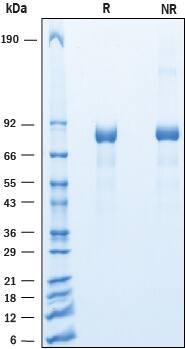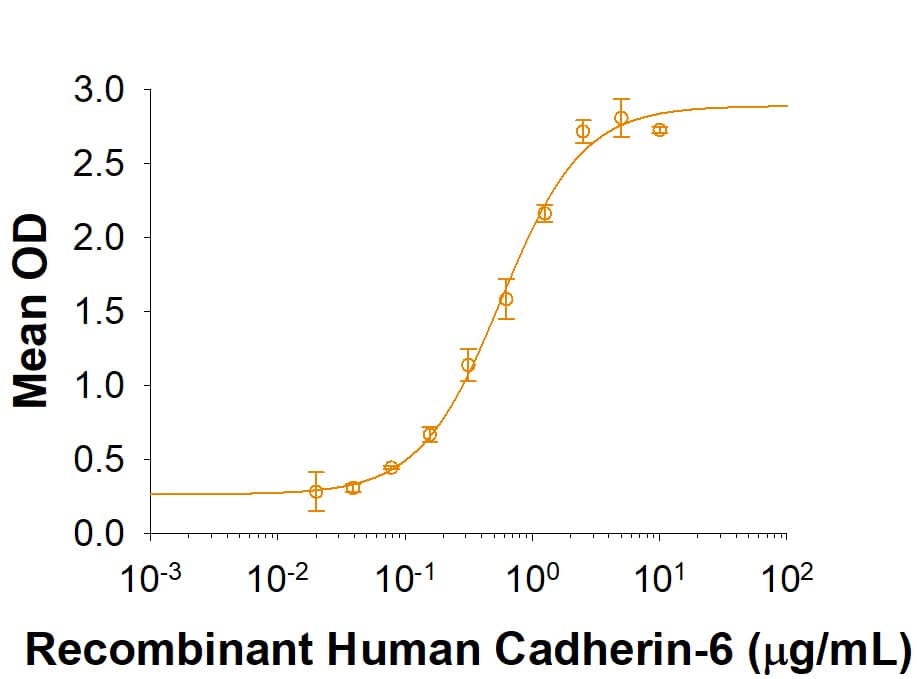Recombinant Mouse Cadherin-9 His-tag Protein, CF
R&D Systems, part of Bio-Techne | Catalog # 1456-CA

Key Product Details
Product Specifications
Source
Human embryonic kidney cell, HEK293-derived mouse Cadherin-9 protein
| Mouse Cadherin-9 (Gly53-Ala614) Accession # P70407 |
HPGGGSGGGSGGGS | HHHHHH |
| N-terminus | C-terminus |
Purity
>90%, by SDS-PAGE visualized with Silver Staining and quantitative densitometry by Coomassie® Blue Staining.
Endotoxin Level
<0.10 EU per 1 μg of the protein by the LAL method.
N-terminal Sequence Analysis
Gly53
Predicted Molecular Mass
64.4 kDa
SDS-PAGE
75-85 kDa, under reducing conditions
Activity
Measured by its binding ability in a functional ELISA.
When Recombinant Mouse Cadherin-9 is immobilized at 1 μg/mL, 100 μL/well, Recombinant Human Cadherin-6/KCAD Fc Chimera Recombinant Human Cadherin‑6/KCAD Fc Chimera (Catalog # 2715-CA) binds with an ED50 of 0.25-1.5 μg/mL.
When Recombinant Mouse Cadherin-9 is immobilized at 1 μg/mL, 100 μL/well, Recombinant Human Cadherin-6/KCAD Fc Chimera Recombinant Human Cadherin‑6/KCAD Fc Chimera (Catalog # 2715-CA) binds with an ED50 of 0.25-1.5 μg/mL.
Scientific Data Images for Recombinant Mouse Cadherin-9 His-tag Protein, CF
Recombinant Mouse Cadherin-9 His-tag Protein Binding Activity
When Recombinant Mouse Cadherin 9 is immobilized at 1 µg/mL, 100 µL/well, Recombinant Human Cadherin-6/KCAD Fc Chimera Recombinant Human Cadherin-6/KCAD Fc Chimera (Catalog # 2715-CA) binds with an ED50 of 0.25-1.5 µg/mL.Recombinant Mouse Cadherin-9 His-tag Protein SDS-PAGE
2 μg/lane of Recombinant Mouse Cadherin-9 was resolved with SDS-PAGE under reducing (R) and non-reducing (NR) conditions and visualized by Coomassie® Blue staining, showing bands at 75-85 kDa.Formulation, Preparation and Storage
1456-CA
| Formulation | Lyophilized from a 0.2 μm filtered solution in PBS. |
| Reconstitution | Reconstitute at 400 μg/mL in PBS. |
| Shipping | The product is shipped at ambient temperature. Upon receipt, store it immediately at the temperature recommended below. |
| Stability & Storage |
|
Background: Cadherin-9
References
- Gumbiner, B.M. (2005) Nat. Rev. Mol. Cell Biol. 6:622.
- Hirano S and Takeichi M. (2012) Physiol Rev. Apr; 92(2):597.
- Nollet et al. (2000) J Mol Biol. Jun 9; 299(3):551.
- Thedieck, C. et al. (2007) PLoS One. 2(8):e657.
- Williams ME et al. (2011) Neuron. Aug. 25; 71(4):640.
- Shimoyama, Y. et al. (2000) Biochem. J. 349:159.
- Wang K. et al. (2009) Nature 459:528.
- Inoue YU and, Inoue T. (2016) Sci Rep. 6:31227.
- Yan G. et al. (2017) Scientific Reports volume 7:10023.
Alternate Names
Cadherin9, CDH9, T1-Cadherin
Gene Symbol
CDH9
UniProt
Additional Cadherin-9 Products
Product Documents for Recombinant Mouse Cadherin-9 His-tag Protein, CF
Product Specific Notices for Recombinant Mouse Cadherin-9 His-tag Protein, CF
For research use only
